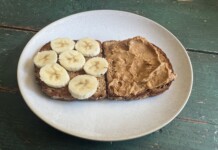By Heather Casey — As wildfires become more frequent and severe, cyclists and outdoor enthusiasts often find themselves exposed to smoke and poor air quality. This exposure can lead to respiratory issues, decreased performance, and overall health concerns. Fortunately, certain foods can help our bodies filter and process the harmful particles found in wildfire smoke. Here’s how to optimize your diet to support your health during wildfire season.
The Science Behind Smoke Exposure
Wildfire smoke contains a mixture of harmful pollutants, including particulate matter (PM2.5), carbon monoxide, and volatile organic compounds (VOCs). These substances can cause oxidative stress and inflammation in the body, particularly affecting the respiratory system.

Nutrients That Help Combat Smoke Exposure
One of the most effective ways to counteract the negative impacts of wildfire smoke is through a diet rich in specific nutrients known for their antioxidant and anti-inflammatory properties.
Antioxidants are your first line of defense. Vitamin C, for example, is a potent antioxidant that helps neutralize free radicals generated by smoke exposure. Citrus fruits, berries, bell peppers, and broccoli are excellent sources of vitamin C. A morning smoothie packed with these ingredients can be a refreshing way to start your day with a health boost.
Vitamin E is another crucial antioxidant that protects cells from oxidative damage. This fat-soluble vitamin is abundant in nuts, seeds, spinach, and avocados. Imagine a vibrant spinach salad topped with avocado slices and a sprinkle of sunflower seeds – a simple yet powerful meal to support your body’s defenses.
Omega-3 Fatty Acids are renowned for their anti-inflammatory properties. These healthy fats, found in fatty fish like salmon and mackerel, as well as in flaxseeds and walnuts, can help reduce inflammation caused by smoke inhalation. Consider adding a serving of grilled salmon or a handful of walnuts to your daily diet to harness these benefits.
Flavonoids are compounds found in foods such as berries, apples, onions, and dark chocolate. They offer strong antioxidant and anti-inflammatory effects. Incorporating a variety of these foods into your meals can provide a delightful way to boost your intake of these beneficial compounds. Think of a delicious berry parfait or a savory dish with caramelized onions – both tasty and healthful!
Cruciferous Vegetables like broccoli, cauliflower, and Brussels sprouts contain compounds that help detoxify the body and reduce inflammation. These veggies can be easily integrated into your diet through stir-fries, roasted vegetable medleys, or even as a crunchy snack.
Practical Dietary Tips
To make the most of these powerful nutrients, aim for a diverse and colorful diet. Here are some practical tips to help you integrate these foods into your daily routine:
- Increase Your Fruit and Vegetable Intake: Aim for a colorful plate filled with a variety of fruits and vegetables to ensure a wide range of antioxidants and nutrients. Try to incorporate at least one serving of fruits or vegetables in every meal and snack.
- Include Omega-3 Rich Foods: Incorporate fatty fish into your diet at least twice a week. For plant-based options, add flaxseeds or chia seeds to your smoothies or oatmeal. These tiny seeds pack a big nutritional punch and are easy to add to many dishes.
- Snack on Nuts and Seeds: Almonds, walnuts, and sunflower seeds are great snacks that provide vitamin E and healthy fats. Keep a small container of mixed nuts with you for a convenient, nutrient-dense snack.
- Stay Hydrated: Water helps to flush out toxins from your body. Aim to drink at least eight glasses of water a day, and consider herbal teas like green tea, which can provide additional antioxidants. Proper hydration is key to maintaining overall health, especially when dealing with smoke exposure.
Sample Day of Eating
To give you an idea of how to incorporate these foods into your daily diet, here’s a sample meal plan:
- Breakfast: Smoothie with spinach, berries, flaxseeds, and almond milk.
- Lunch: Salad with mixed greens, bell peppers, broccoli, and a salmon filet.
- Snack: An apple with a handful of walnuts.
- Dinner: Stir-fry with tofu, cauliflower, and Brussels sprouts, served with brown rice.
- Hydration: Throughout the day, drink plenty of water and green tea.
Conclusion
By incorporating these nutrient-dense foods into your diet, you can help your body better filter and process the harmful pollutants from wildfire smoke. As cyclists and outdoor enthusiasts, maintaining our health and performance during wildfire season is crucial. Stay safe, eat well, and continue to enjoy the great outdoors!
References
- Harvard Health Publishing on Omega-3s and Heart Health: Omega-3 fats and your heart
- The Nutrition Source – Harvard T.H. Chan School of Public Health: Omega-3 Fatty Acids: An Essential Contribution
- Harvard Health Publishing on Omega-3 Rich Foods: Omega-3-rich foods: Good for your heart











